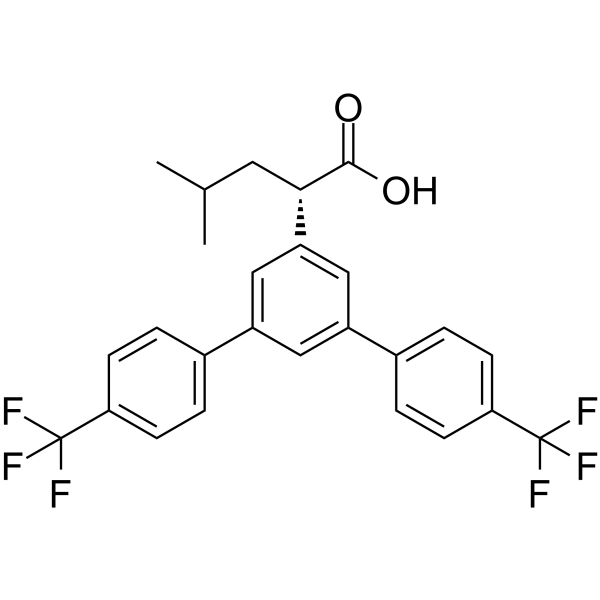| Description |
JNJ-40418677 is an orally active modulator of γ-secretase, can cross the blood-brain barrier. JNJ-40418677 inhibits Aβ42 and NS2B-NS3 protease, with IC50s of 200 nM and 3.9 μM, respectively. JNJ-40418677 displays good biological tolerance, can be use for Alzheimer’s disease research[1][2][3].
|
| Related Catalog |
|
| Target |
IC50: 185 nM (rat Aβ42)[1]; 200 nM (human Aβ42)[2]; 3.9 μM (ZIKV NS2B-NS3 protease)[3]
|
| In Vitro |
JNJ-40418677 (0.2 nM-0.3 mM; 16 h) selectively reduces Aβ42 secretion in cell culture supernatants of human neuroblastoma cells with mean IC50 of 200 nM and (0.2 nM-0.3 mM; 48 h) of rat primary neurons with mean IC50 of 185 nM[1]. JNJ-40418677 (10 μM, 100 μM; 18 h) does not inhibit Notch processing or (6 nM-20 μM; 18 h) not affect formation of other amyloid precursor protein cleavage (CTF-β, CTF-α) products, and shows no inhibitory activity against COX-1/2 at a high concentration of 60 μM[1]. JNJ-40418677 suppresses ZIKV in human neuronal stem cells with an EC50 value of 3.2 μM, and inhibits ZIKV NS2B-NS3 protease with an IC50 value of 3.9 μM[3]. Western Blot Analysis[1] Cell Line: HEK293 cells Concentration: 10 μM Incubation Time: 18 h Result: Resulted Aβ42 decreasing, Aβ38 increasing and Aβ40 levels remained unchanged.
|
| In Vivo |
JNJ-40418677 (10-300 mg/kg; p.o.) decreases Aβ42 brain levels in a dose-dependent manner 4 h after treatment, while increasing Aβ38 level in non-transgenic mouse brain[1]. JNJ-40418677 (30 mg/kg; p.o.; once) shows the mean brain and plasma levels 4 h after single dose are both 17 μM, indicating good brain penetration in non-transgenic mouse brain[1]. JNJ-40418677 (20-120 mg/kg; p.o.; 7 months) has good biological tolerance with no adverse effects in a chronic treatment in Tg2576 mice[1]. JNJ-40418677 (20-120 mg/kg; p.o.; 7 months) decreases the plaque number and the area occupied by plaques in Tg2576 mice dose-dependently[1]. Animal Model: Non-transgenic mouse (6-month-old)[1] Dosage: 10, 30, 100, 300 mg/kg Administration: Oral gavage; once Result: Reduced the Aβ42 brain levels dose-dependently, with 82%, 64%, 39%, and 31% at the doses of 10, 30, 100, 300 mg/kg, respectively. Animal Model: Tg2576 mice (6-month-old)[1] Dosage: 20, 60, 120 mg/kg Administration: Oral gavage; 7 months Result: Exhibited well tolerated activity, without adverse effects on body weight. Showed no influence on the steady state levels of full-length APP, CTF-a, and CTF-b at a dosage of 120 mg/kg. Significantly reduced plaque area fraction and number of plaques.
|
| References |
[1]. Van Broeck B, et al. Chronic treatment with a novel γ-secretase modulator, JNJ-40418677, inhibits amyloid plaque formation in a mouse model of Alzheimer's disease. Br J Pharmacol. 2011 May;163(2):375-89. [2]. Harrie J.M. Gijsen, et al. Chapter Five - Secretase Inhibitors and Modulators as a Disease-Modifying Approach Against Alzheimer's Disease. Annu Rep Med Chem. 2012. 47:55-69. [3]. Samrat SK, et al. Antiviral Agents against Flavivirus Protease: Prospect and Future Direction. Pathogens. 2022 Feb 25;11(3):293.
|

